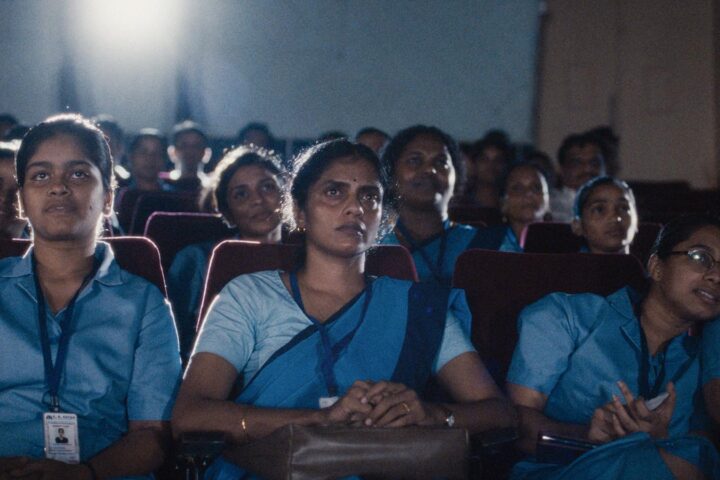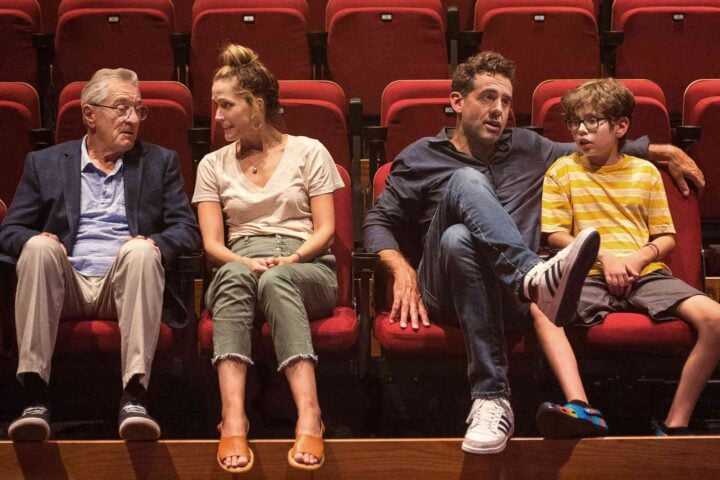The sky is blue in Payal Kapadia’s revelatory All We Imagine as Light. It’s in the heathered cornflower blue of morning, still cottoned over with sleep, as well as in the gnashing, striated blues (cobalt, steely Carolina, rusted-over aquamarine) of the afternoon grind. And when the sun gives way to the horizon, indigo blossoms like ink in a well of midnight.
The hues of Kapadia’s blues run so deep that they bleed across the entire canvas of the film, from the support beams of a lumbering pedestrian highway crossing where two characters share a wordless intimacy, to the panels of a bathroom door where blue towels are scrubbed over a blue bin, to the workwear and casual dress of her hospital-worker protagonists. And, of course, the sea, where they all end up by the end of All We Imagine as Light.
That Kapadia is able to render such a richly varied emotional texture from an aesthetic palette this constrained and contemplative isn’t merely a testament to her skill as a filmmaker; it’s an emblem of the process that powers the core of All We Imagine as Light. This is fundamentally a film about Mumbai. Kapadia evokes her adopted home with as much vivid clarity and bracing honesty as Jia Zhang-ke does Shanxi, or Elena Ferrante does Naples, because she has taken its animating principle—the reconciliation of opposites—as her own.
All We Imagine as Light’s characters are circumscribed by social disadvantages and personal hardships, yet they maintain a stubborn freedom. Its urban landscape is gaseous, gyrating, dizzyingly complex. Yet when night falls, it’s quiet and poetic, drawing you into an embrace. Kapadia’s mode of understanding and constructing her Mumbai on screen makes fluid shifts from the cerebral to the viscerally sensual to the didactically political. These are tectonic transitions occurring on the level of the form, and Kapadia makes them look effortless.
Kapadia’s first fiction feature follows the lives of three women who work in a Mumbai hospital. Prabha (Kani Kusruti) is the hospital’s head nurse. Thoughtful and taciturn, she is met some nights after work by the handsome Dr. Manoj (Azeez Nedumangad), who walks her to the commuter train. Prabha shares an apartment with Anu (Divya Prabha), a youthful and flirtatious receptionist in the giddy throes of first love with the endearingly devoted Shiaz (Hridhu Haroon). The two women both used to work with Parvaty (Chhaya Kadam), a recent widow and retiree who’s fierce, loving, and involved in a local workers’ organization.
Cinematographer Ranabir Das’s use of diffused light, slow pans, tilts, and zooms, production designer Shamim Khan’s naturalistically over-decorated, time-worn sets, and the mix of intimately recorded voiceover and twinkling jazz instrumentals are all carefully modulated to produce a tone that’s light but never airless. As for the film’s pace, Kapadia’s keeps it slow but never languorous. Monsoon season itself is tamed into submission. Gently, Kapadia begins to let in enough water to expose the cracks in each characters’ foundation.
Parvaty is being forced out of the apartment she shared with her late husband to make way for a luxury highrise, and doesn’t have citizenship papers to protect her. “Class is a privilege reserved for the privileged” reads an advertisement for the new development. Anu and Shiaz’s love is pure, but she’s Hindu and he’s Muslim—a pairing that the Modi regime has done everything it can to deem irreconcilable. The arrival of a fancy rice cooker from an unknown sender blows thunderous storm clouds across Prabha’s eyes after Anu discovers it’s from Germany. It turns out that Prabha was in an arranged marriage back in her village in Kerala. Her husband moved to Germany to work in a factory shortly after, and they’ve since completely lost touch.
Each of All We Imagine as Light’s women is caught in a holding pattern. The gradual revelation of the binds that tie them down pulls us back to the film’s enigmatic opening. Documentary-style footage of Mumbai street life—a bridge back to Kapadia’s body of documentary work—is accompanied by vox populi recordings of Mumbaikars talking about the city. “I’ve lived here 23 years, but I’m afraid to call it home,” one says. “The city takes time away from you,” says another. One recording, easy to miss in the mesh of contrasting voices, comes back like a prophecy: “Every family in the village has at least one person who lives in Mumbai.”
Prabha, Anu, and Parvaty are all from somewhere else. The medium which Kapadia chooses to construct her film within is personal, but her message is political. This is the painful dialectic that extreme urban development thrusts onto people and their land. You want work? Move to the city. But leave behind your family, your language, your way of life, and struggle to adapt with no guarantee of success, your feet continually straddling two worlds.
Dr. Manoj, for one, is overjoyed by Prabha’s company partly because he struggles to learn Hindi and they can speak Malayalam together. Belonging to an older generation than her two friends, Parvaty presumably moved to Mumbai to benefit from the radical liberal reforms of the early ’90s. But now that Mumbai has assumed its place among the elite metropoles of the world, she’s rudely shoved out, forced to return to Kerala—a trek that so many made 30 years ago in reverse. “When people go abroad they can lose their minds, or their memories,” she remarks to Prabha about her itinerant husband, but she could be speaking about any of the characters here.
What’s particularly notable about Kapadia’s approach to this well-trod material is the choice to contrast her characters’ sense of confinement with capacious and elastic camerawork. A static wide shot of Prabha reading a poem that Manoj wrote to her—a cry of desire that she can’t reciprocate—is interrupted by a glimmering train filling the nightscape behind her with light, a sign of life in motion. Other static close-ups yield to pans and tilts so slow you must momentarily unfocus from the character to discern them, reminding viewers of the open, evanescent world around the characters. Meanwhile, Anu and Shiaz’s love scenes are captured with reverent attention, eschewing typical strategies of crosscutting and montage.
With this follow-up to A Night of Knowing Nothing, her 2021 docufiction about the student protest movements that swept India after the death of anti-caste student activist Rohith Vemula, Kapadia has created an exceptional document of a city and its people. And it’s one that’s generous to its characters without condescending, as well as honest without oversimplifying.
Since 2001, we've brought you uncompromising, candid takes on the world of film, music, television, video games, theater, and more. Independently owned and operated publications like Slant have been hit hard in recent years, but we’re committed to keeping our content free and accessible—meaning no paywalls or fees.
If you like what we do, please consider subscribing to our Patreon or making a donation.




